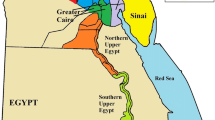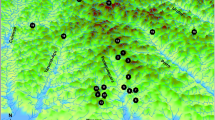Abstract
The electrophoretic mobilities of 52 enzymes and proteins were used as measures of the genetic similarity between the sibling species Microtus arvalis and M. subarvalis. The two vole species differed in the electrophoretic mobilities of seven (glucose-6-phosphate dehydrogenase, adenylate kinase, diaphorase, lactate dehydrogenase-A, α-galactosidase, 6-phosphogluconate dehydrogenase, and hemoglobin) of these markers. This allowed us to accept the seven markers assayed as species-specific markers. Based on the frequency distribution of the genes at the polymorphic loci of M. arvalis and M. subarvalis, the degree of their genetic similarity was estimated as 0.312 and the genetic distance as 1.164 by Nei's formula. The estimates for genetic similarity were close to those obtained for species recognized as distinct.
Similar content being viewed by others
References
Ayala, F. J., Tracy, M. L., Barr, L. G., and Ehrenfeld, J. G. (1974). Genetic and reproductive differentiation of the subspecies, Drosophila equinoxialis caribbemsis. Evolution 2824.
Dobrokhotov, B. P., and Malygin, V. M. (1982). Use of electrophoresis of hemoglobins for identification of grey voles (Microtus) of the arvalis group (Rodentia, Cricetidae). Zool. J. 61436 (Russian).
Harris, H., and Hopkinson, D. A. (1976). Handbook of Enzyme Electrophoresis in Human Genetics North-Holland, Amsterdam.
Lewontin, R. C. (1974). The Genetic Basis of Evolutionary Change Columbia University Press, New York.
Mayr, E. (1963). Animal Species and Evolution Harvard University Press, Cambridge, Mass.
Meyer, M. N., Orlov, V. N., and Scholl, E. D. (1969). Application of data karyological, physiological and cytophysiological analyses to identification of new species in rodents. Dokl. AN USSR 1881411.
Meyer, M. N., Orlov, V. N., and Scholl, E. D. (1972). Sibling species in the group Microtus arvalis (Rodentia, Cricetidae). Zool. J. 51724.
Meyer, M. N., Moroz, A. M., Orlov, V. N., and Scholl, E. D. (1973). Zwillingsarten der Feldmause, Microtus arvalis (Pallas). Mitt. Zoll. Mus. Berlin 49387.
Meyer, M. N., Grishchenko, T. A., and Zybina, E. V. (1981). Experimental hybridization as a method for analysing the degree of divergence of closely related species. Zool. J. 60290 (Russian).
Nei, M. (1972). Genetic distance between populations. Am. Natur. 106283.
Nei, M. (1976). Mathematical models of speciation and genetic distance. In Karlin, S. (ed.), Population Genetics and Ecology Academic Press, New York, San Francisco, London.
Selander, R. K., and Johnson, W. E. (1973). Genetic variation among vertebrate species. Annu. Rev. Ecol. Syst. 475.
Serov, O. L. (1973). Genetic control of two esterases of rat plasma (Rattus norvegicus). Biochem. Genet. 9117.
Slobodyanyuk, S. Y., and Serov, O. L. (1983). Variations in the expression of the gene Pgd due to the effect of chromosomal rearrangements in Drosophila melanogaster. Mol. Gen. Genet. 191372.
Author information
Authors and Affiliations
Rights and permissions
About this article
Cite this article
Zakijan, S.M., Kulbakina, N.A., Serov, O.L. et al. An estimation of the degree of the genetic divergence of sibling species Microtus arvalis and Microtus subarvalis (Rodentia) based on electrophoretic analysis. Biochem Genet 22, 1081–1091 (1984). https://doi.org/10.1007/BF00499633
Received:
Revised:
Issue Date:
DOI: https://doi.org/10.1007/BF00499633




